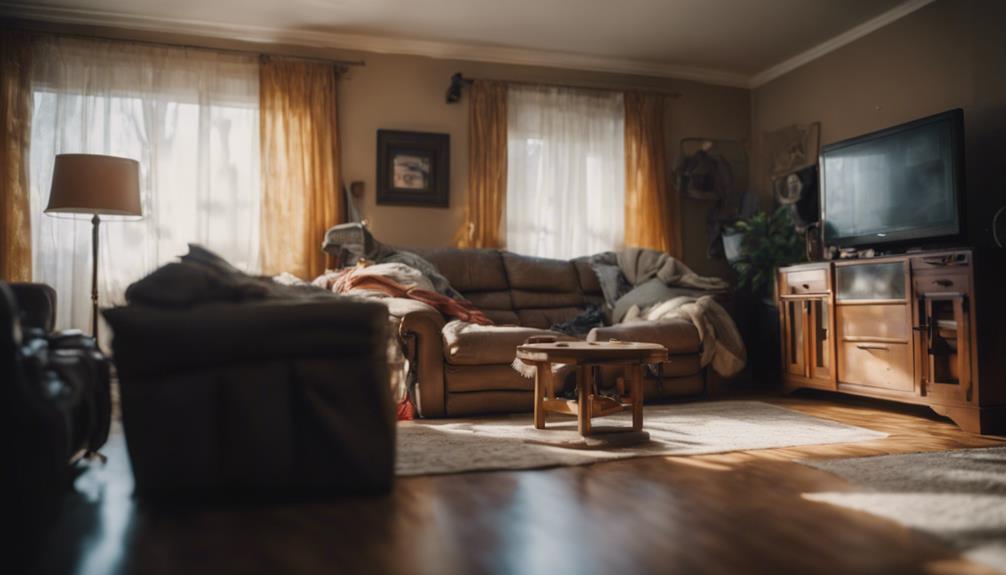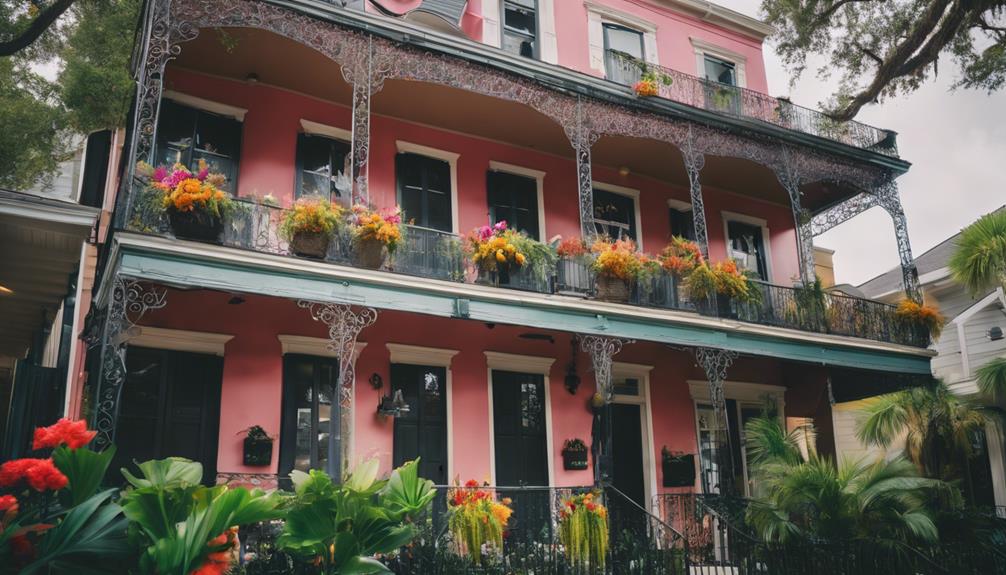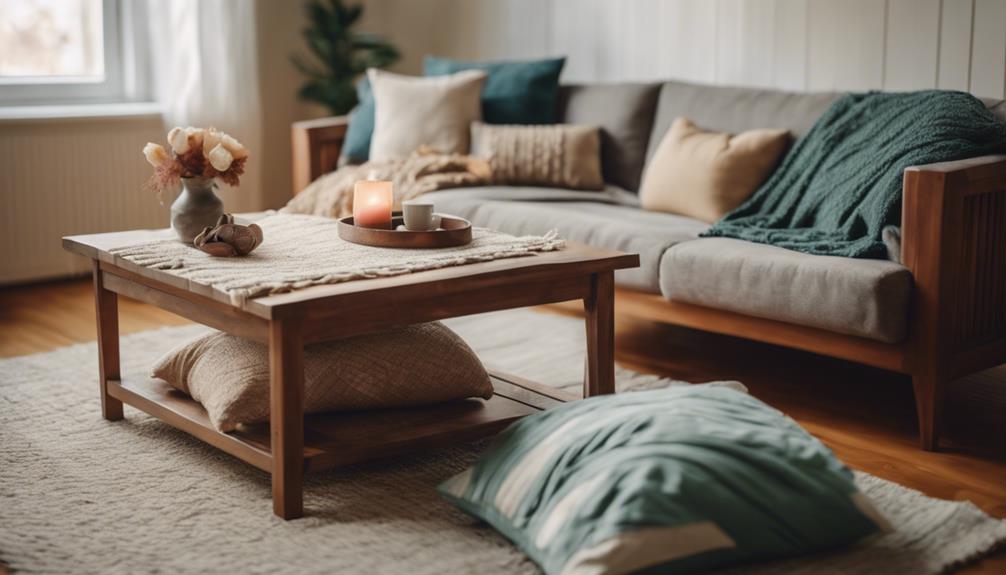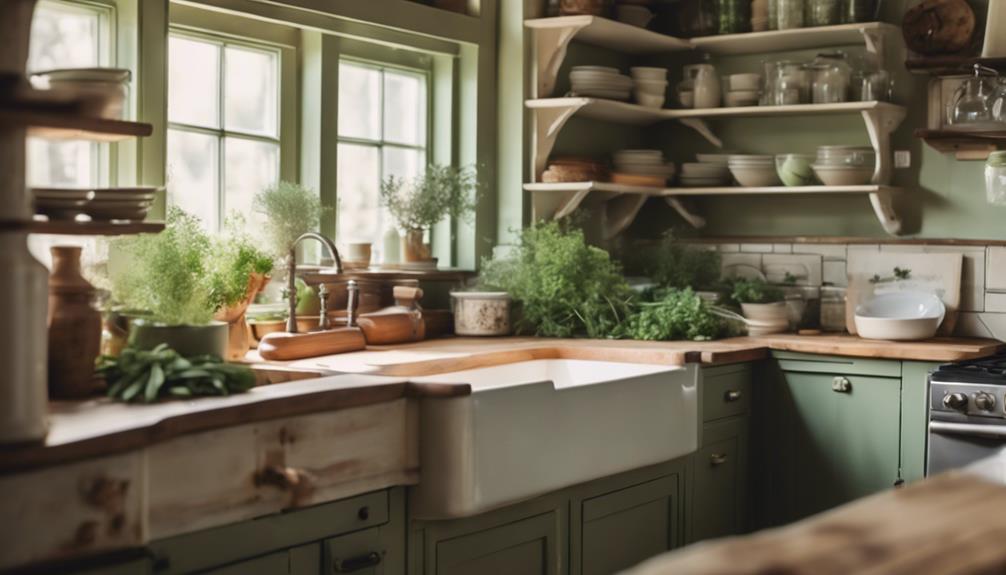In order to establish a harmonious atmosphere, it is important to steer clear of common Feng Shui pitfalls. Begin by ensuring your space is clutter-free; excess items can obstruct positive chi energy flow. Get rid of or repair any damaged goods, as they can bring in negative energy. Be mindful of plant selection- avoid thorny plants that disrupt harmony. When it comes to artwork, choose pieces that inspire positivity and stay away from images depicting disasters. Arrange furniture in a way that promotes smooth energy flow and aim for balanced décor with matching pairs. Lastly, ensure your bedroom radiates love and happiness. By making these changes, your home can transform into a haven of positive energy, with more useful tips waiting for you ahead.
Key Takeaways
- Regularly declutter your space to prevent stagnant energy and promote positive Chi flow.
- Avoid keeping broken items, as they disrupt energy and invite negativity into your home.
- Choose non-thorny, air-purifying plants to maintain harmony and enhance well-being.
- Select uplifting artwork; avoid negative or aggressive imagery that can induce anxiety.
- Ensure furniture placement allows for open pathways to facilitate the smooth flow of Chi.
Understanding Feng Shui Principles

Understanding Feng Shui principles is vital if you want to create a harmonious living space. At its core, Feng Shui emphasizes the flow of Chi, or positive energy, which can greatly influence your well-being and fortune.
To harness this energy, you need to evaluate key elements like the balance of Yin and Yang and the Five Elements: fire, earth, metal, water, and wood. Incorporating decor that reflects cultural artistry, such as traditional Indonesian masks, can enhance the energy of your home and tell stories that resonate with your personal journey.
One significant aspect is the careful arrangement of your furniture. You'll want to position items to enhance energy flow rather than block it. For instance, avoid placing mirrors directly facing your bed or internal doors, as this can disrupt harmony and create unease.
Additionally, be mindful of clutter, as it generates Sha Chi, or stagnant energy, which can lead to physical and emotional blockages.
The Dangers of Clutter

Clutter creates stagnant energy in your home, blocking the positive flow of Chi.
Incorporating elements like Indonesian Decorative Pillows can add vibrancy and comfort to your space while minimizing clutter.
When you let go of unnecessary items, you invite clarity and abundance into your life.
Regular decluttering not only enhances your space but also supports your emotional well-being.
Clutter Creates Stagnant Energy
Have you ever noticed how a messy space can drain your energy? Clutter is more than just an eyesore; it's the primary man-made source of Sha Chi, generating stagnant energy that disrupts the flow of Chi within your home.
When you're surrounded by clutter, it not only reflects a cluttered mind but also contributes to emotional blockages and physical ailments. This negative energy can weigh you down, making it harder to feel motivated or at peace.
To maintain a harmonious environment, you've got to tackle hidden spaces like cupboards and garages regularly. These areas often accumulate unseen clutter that adds to the stagnation.
By organizing and cleaning these spots, you can greatly reduce stress and anxiety levels, fostering a healthier mindset.
Creating a clean, organized environment invites abundance and enhances your overall well-being. When Chi flows freely, it brings clarity and positive energy into your life.
So, take a moment to assess your surroundings. If you find clutter lurking, it's time to take action and reclaim your space.
You'll be amazed at how a little decluttering can transform your energy and elevate your mood.
Decluttering Promotes Positive Flow
Tackling clutter not only clears your physical space but also opens up pathways for positive energy to flow freely throughout your home. Incorporating natural materials and a harmonious design, as seen in traditional Indonesian style home decor, can further enhance this positive flow.
Clutter is the primary source of Sha Chi, creating stagnant energy that can lead to stress and illness in your environment. When your space is cluttered, it reflects a cluttered mind, impacting your emotional well-being and overall life satisfaction.
To promote a positive flow of Chi, make decluttering a regular habit. Don't overlook hidden spaces like cupboards and garages, as they can harbor stagnant energy. A clean and organized environment invites flowing Chi, enhancing your mood and attracting abundance.
You'll feel lighter and more focused when you clear away unnecessary items. Consider gradual decluttering strategies. Start small, tackling one area at a time to avoid feeling overwhelmed.
Impact of Broken Items

When you leave broken items in your home, you invite Sha Chi to disrupt the flow of positive energy, which can take a toll on your well-being.
Those damaged objects don't just clutter your space; they also impact your mental and emotional state. Daily exposure to broken items can create feelings of being broken yourself, leading to unnecessary stress and unease.
Incorporating thoughtful decor, such as a vibrant Indonesian decor mask, can help uplift your environment and promote positive energy.
To foster a healthy environment, it's essential to address these issues. Repairing or discarding broken items restores respect for your home and invites fresh, positive Chi into your living space.
Imagine how revitalizing it feels when you replace an old, damaged item with something new or fixed; it enhances energy dynamics and contributes to a more vibrant atmosphere.
Choosing the Right Plants

When choosing plants for your home, avoid thorny varieties like cacti that can disrupt your space's harmony.
Instead, opt for air-purifying species like Golden Pothos or Jade plants to enhance the flow of positive energy.
Incorporating elements of nature, such as lush greenery, can create a more inviting atmosphere and align with Balinese Interior Design Concepts that emphasize a connection to the environment.
Don't forget to remove any dead or dying plants promptly to keep your environment vibrant and welcoming.
Avoid Thorny Plants
Many homeowners unknowingly invite negative energy into their spaces by keeping thorny plants like cacti and Agave indoors. These plants disrupt the positive Chi flow, creating discomfort and defensiveness among family members. Maintaining a thorn-free environment is essential for fostering harmony and enhancing your home's ambiance.
| Thorny Plants | Alternatives |
|---|---|
| Cacti | Golden Pothos |
| Agave | Jade Plant |
| Creeping Plants | Ferns or Spider Plants |
Instead of thorny plants, opt for vibrant, leafy greenery that promotes positivity and prosperity. Golden Pothos and Jade plants not only beautify your space but also contribute to a healthier atmosphere. Avoid creeping plants since they can lead to dependency issues and deplete your living space's positive energy.
Choose Air-Purifying Species
Choosing the right plants can transform your home into a sanctuary of fresh air and positive energy. Incorporating elements of cultural decor, like Indonesian masks, can further enhance the ambiance of your space. Opting for air-purifying species helps filter out toxins, creating a healthier living environment.
Here are three plants you should consider:
- Golden Pothos – This hardy plant thrives in low light and effectively removes formaldehyde from the air.
- Snake Plant – Known for its resilience, it converts CO2 into oxygen at night, making it perfect for bedrooms.
- Spider Plant – This cheerful plant is excellent at filtering benzene and can adapt to various conditions.
Incorporating these plants into your living room not only enhances air quality but also promotes a vibrant atmosphere.
Be mindful that neglecting your plants can bring misfortune into your space; dead leaves can accumulate Sha Chi, disrupting positive energy. Regular maintenance is key to ensuring your plants thrive.
Place them in areas with ample natural light, steering clear of thorny varieties, to optimize Feng Shui. By choosing the right air-purifying plants, you're not just decorating—you're inviting health and harmony into your home.
Additionally, consider the aesthetic impact of decor pieces like Indonesian decor masks to complement your plant choices and create a cohesive look.
Remove Dead Plants
How can you create a truly harmonious living space? Start by understanding the importance of your plants. Dead plants invite Sha Chi, disrupting the positive energy flow in your home.
It's vital to promptly remove dead plants to maintain that essential harmony. Regularly inspect your indoor garden and replace any wilting or dying plants. Neglected plants can create negative energy, dragging down the overall vibe of your space.
For those looking to enhance their interiors with a tropical touch, consider consulting experts like Mahallati Interiors for luxury tropical designs.
Instead, focus on incorporating healthy indoor plants like Golden Pothos or Jade plants. These not only purify the air but also symbolize prosperity, enhancing the energy of your living area.
Artwork and Positive Energy

Artwork plays an essential role in shaping the energy of your home, influencing your mood and overall atmosphere. Choosing the right pieces can enhance positive energy, while the wrong ones might generate Sha Chi, disrupting your serenity.
For instance, incorporating vibrant floral displays can add a lively touch that elevates your space.
Here are three key tips to contemplate when selecting artwork:
- Choose Uplifting Imagery: Opt for landscapes, joyful scenes, or motivational quotes that evoke positive emotions. These types of artwork promote harmonious energy throughout your space.
- Avoid Negative Themes: Steer clear of images depicting disasters, war, or chaos. Such artwork can trigger negative feelings and contribute to an unhealthy energy flow.
- Mind the Placement: Be mindful of where you hang your artwork. Low-hanging pieces can lead to feelings of depression and anxiety, while well-placed art can uplift and inspire.
Essential Furniture Placement

In the domain of Feng Shui, essential furniture placement can greatly influence the energy flow within your home. Start by positioning your desk in a "power position," where you can face the entrance while seated. This setup fosters openness to opportunities and enhances productivity.
To further enhance this environment, consider integrating elements inspired by traditional Indonesian housing, such as natural materials that promote a sense of tranquility. Avoid blocking pathways with furniture, as this disrupts the flow of Chi and can create feelings of congestion and anxiety.
When arranging your seating, prioritize conversation and connection. Chairs should face each other instead of being pushed against walls. This creates a welcoming environment, allowing for meaningful interactions.
For your bedroom, place the bed away from direct alignment with the front door. This promotes restful sleep and a sense of security while still allowing you to see the entrance.
Lastly, be mindful of visual balance across the room. Arrange your furniture to create an even distribution of weight, preventing one side from feeling overly heavy or cluttered. This balance contributes to overall harmony and enhances the positive energy in your space.
Decorate in Balanced Pairs

Creating a harmonious environment goes beyond furniture arrangement; it also involves the thoughtful use of decor elements. According to Feng Shui, decorating in balanced pairs is essential for promoting positive Chi in your living space. It helps to create a sense of harmony and symmetry, making your home feel more inviting.
Incorporating elements inspired by tropical villa plans can enhance this effect, as these designs emphasize open spaces and natural light that contribute to a serene atmosphere.
Here are three ways to incorporate balanced pairs in your decor:
- Lighting: Use matching bedside lamps or wall sconces to enhance the aesthetic appeal and create a cohesive look in your bedroom or living room.
- Textiles: Choose pairs of cushions or throws that complement each other, adding both style and comfort to your seating areas.
- Artwork: Hang identical or complementary pieces of art on opposite walls to foster a sense of balance and stability among occupants.
Symmetrical styling not only adds chicness to your designs but also restores balance, ensuring that the overall energy flow remains harmonious throughout your home.
Creating a Loving Bedroom

A loving bedroom serves as a personal sanctuary where you can unwind and feel cherished. To create this nurturing environment, make certain your space contains only items that evoke feelings of love and happiness. This promotes a positive emotional atmosphere that enhances your well-being.
Start by replacing any old or disliked decor. Outdated or unpleasant items can weigh down the energy in your room. Instead, focus on soft, calming colors and textures, which encourage relaxation and restful sleep. Choose soothing shades for your walls, bedding, and decor that help you feel at ease.
Incorporate elements that symbolize love and connection. Paired items, such as matching nightstands or lamps, can foster a sense of togetherness.
Positive affirmations displayed in your bedroom can uplift your spirit and remind you of the love surrounding you.
Avoiding Negative Imagery

When it comes to your home, displaying negative imagery can really throw off the positive energy you want to cultivate.
Instead, consider choosing art that inspires and uplifts, creating a more harmonious environment.
Impact of Negative Imagery
Negative imagery in home decor can considerably disrupt the positive flow of energy, or Chi, within your living space.
When you surround yourself with art that depicts war, natural disasters, or aggressive animals, you're inviting negativity that can lead to feelings of anxiety and distress.
Here's what you need to take into account:
- Destructive Scenes: Art depicting destruction or barren landscapes can invite suffering for your loved ones, negatively impacting overall well-being in your home.
- Aggressive Imagery: Displaying aggressive or dead animal imagery can disturb sleep, especially in children, making it essential to remove such pieces from your living spaces.
- Create a Separate Gallery: Feng Shui principles suggest keeping disaster images outside your home, ensuring your indoor atmosphere remains positive and harmonious.
Recommended Art Choices
Choosing the right artwork can greatly enhance the energy in your home. To foster a positive atmosphere, steer clear of pieces that depict disasters, violence, or destruction. Such imagery disrupts the flow of Chi and can lead to anxiety, particularly among children. Instead, opt for artwork that inspires and uplifts your spirits.
Here's a quick guide for your art choices:
| Avoid | Why | Choose Instead |
|---|---|---|
| War or natural calamities | Disrupts positive energy | Peaceful landscapes |
| Aggressive or violent imagery | Creates anxiety and unrest | Inspirational quotes or affirmations |
| Barren landscapes or destruction | Leads to feelings of hopelessness | Vibrant flora or cheerful scenes |
| Dark or morose themes | Drains energy | Bright, happy colors |
| Negative or disaster-themed art | Harms family dynamics | Art that promotes harmony and joy |
Placement for Positive Energy
To create a harmonious living space, the placement of artwork is just as important as the pieces you select. You'll want to avoid displaying any artwork that depicts disasters, such as wars or natural calamities. These images disrupt positive energy flow and can create feelings of distress within your home.
Instead, focus on imagery that evokes positive emotions.
Consider this list when choosing and placing your artwork:
- Avoid aggressive imagery: Steer clear of images that display aggressive animals or destructive scenes, especially in children's rooms, as they can lead to sleep disturbances.
- Create a designated gallery: Reserve darker or more intense artwork for areas outside the main living spaces, preventing disruption of energy in your home environment.
- Incorporate uplifting pieces: Use inspirational or motivational quotes and uplifting artwork to enhance the emotional well-being of everyone in your household.
Common Feng Shui Mistakes

When it comes to creating a harmonious living space, many people unknowingly make common Feng Shui mistakes that can disrupt the flow of energy in their homes. For instance, placing furniture in a way that blocks doorways or cluttering entryways can prevent positive energy, or “chi,” from circulating freely. It’s important to be mindful of these unintentional errors and take steps to fix bad vibes with feng shui by rearranging key elements and clearing out stagnant areas. Simple adjustments like this can help restore balance and invite a more peaceful, uplifting atmosphere into your home.
One major issue is clutter, which generates Sha Chi, leading to stagnant energy and a cluttered mind. Regularly decluttering all spaces, including hidden areas like cupboards and garages, is essential.
Another mistake is holding onto broken items. They disrupt energy flow, so it's best to repair or discard them promptly, restoring respect for your space and inviting positive Chi.
Additionally, avoid thorny plants like cacti indoors; they emit negative energy that can harm family relationships and overall well-being.
Be mindful of your artwork too. Pieces depicting disasters, wars, or aggressive imagery can create a negative atmosphere, so focus on uplifting and positive imagery instead.
Frequently Asked Questions
What Are the Designs to Avoid According to Feng Shui?
When considering feng shui, you should avoid designs featuring destructive imagery, thorny plants, broken items, mirrors facing the bed, and clutter under the bed. These can disrupt positive energy and affect harmony in your home.
What Is Considered Bad Feng Shui for a House?
If you think clutter's charming, you're in for a surprise! Bad Feng Shui's all around—clutter, broken items, thorny plants, negative art, and misplaced mirrors. They're just waiting to sabotage your peace and happiness!
What Colors Should Be Avoided in Feng Shui?
In Feng Shui, avoid using dark colors like black and muddy tones, which can create stagnation. Bright, harsh colors can overwhelm, while excessive white or gray may lead to feelings of isolation and coldness.
What Are the Feng Shui Rules for a House?
You might think Feng Shui's just about aesthetics, but it's more. Align your front door for Chi flow, declutter to avoid stagnation, and incorporate the Five Elements to create balance in your home's energy.
Conclusion
Incorporating feng shui into your home decor can transform your space and energy. Did you know that 85% of people report feeling more relaxed and focused in environments that embrace these principles? By avoiding clutter, choosing the right plants, and balancing your decor, you can create a harmonious atmosphere. Remember, your home should be a sanctuary of positivity and love. Make these changes today, and you'll likely feel the difference immediately!







